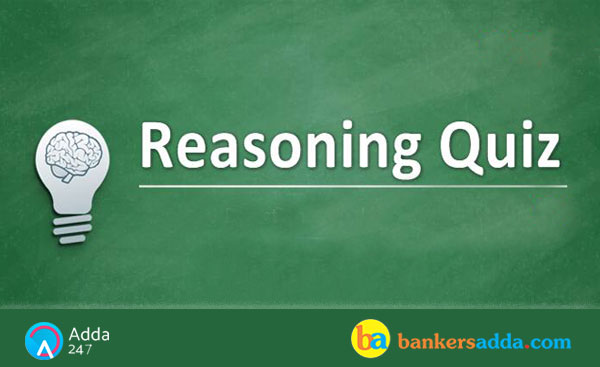Dear Aspirants,


Reasoning Questions for IBPS PO 2018
Reasoning Ability is an onerous section. With the increasing complexity of questions, it becomes hard for one to give it the cold shoulder. The only way to make the grade in this particular section in the forthcoming banking exams like IBPS PO is to practice continuously with all your heart and soul. And, to let you practice with the best of the latest pattern questions, here is the Adda247 Reasoning Quiz based the exact same pattern of questions that are being asked in the exams.
Directions (1-5): Read the following information carefully and answer the question given below:
There are eight persons sitting around a square table. Four of them are sitting at corner of the table and rests are sitting at middle of the table. Those who sit at corner face inside the centre and who sit at middle face outside the centre. They like different colours i.e. red, yellow, pink, white, green, brown, peach, and grey (not necessarily in same order).
L likes pink and sits third to the right of the one who likes red. The one who likes green sits opposite to L. M faces outside the centre and is not an immediate neighbour of the one who likes green. Only two persons sits between M and W, who likes brown. The one who likes peach sits immediate left of W. W sits 2nd to the left of J, who is an immediate neighbour of M. X likes grey and faces inside. K faces inside. The one who likes white sits 2nd right of Y. Z doesn’t face inside.
Q1. Four of the following five are belong to a group, who among the following does not belong to that group?
(a) M
(b) K
(c) L
(d) Y
(e) Z
Q2. If all the persons who face outside the centre are arranged in alphabetical order in a row (from left to right), all are facing north, then who among the following sits second from the right end of the row?
(a) M
(b) L
(c) Z
(d) Y
(e) None of these
Q3. Which of the following should come in the blank spaces to make the following statement true?
X sits ……………… to the left of K and M sits ……………… to the left of L.
(a) Second
(b) Immediate
(c) Third
(d) Fourth
(e) None of these
Q4. Z likes which of the following colour?
(a) Pink
(b) Peach
(c) Grey
(d) White
(e) None of these
Q5. Which of the following is true regarding the one who likes yellow?
(a) faces outside the centre
(b) J doesn’t like yellow
(c) J likes yellow
(d) Z sits just near to the one who likes yellow
(e) None of these
Directions (6-10): In each of the questions below are given two/three statements followed by two conclusions numbered I and II. You have to take the given statements to be true even if they seem to be at variance with commonly known facts. Read all the conclusions and then decide which of the given conclusions logically follows from the given statements, disregarding commonly known facts. Give answer.
(a) If only conclusion I follow.
(b) If only conclusion II follows.
(c) If either conclusion I or conclusion II follows.
(d) If neither conclusion I nor conclusion II follows.
(e) If both conclusion I and conclusion II follow.
Q6. Statements:
All Jewel are Gems.
Some jewel are Unseen.
No VIP are Jewel.
Conclusion:
I. Some Gems are Unseen.
II. All VIP can be Gems.
Q7. Statements:
Some Trend are Fashion.
Some Brand is Trend.
Some Gems are Trend.
Conclusion:
I. No Brand is Gems.
II. Some gems is brand.
Q8. Statements:
Some Error are debug.
Some bug are debug.
All mug are bug.
Conclusion:
I. Some mug are Debug.
II. Some bug are mug.
Q9. Statements:
Some Common are Simple.
All Common are VIP.
Only Highfi is Simple.
Conclusion:
I. Some Simple can never be VIP.
II. Some Common can be Highfi.
Q10. Statements:
Some Geeta are Ram.
Some Seeta are Rishi.
Some Ram are not Seeta.
Conclusion:
I. Some Geeta are not Seeta.
II. All Seeta are Rishi.
Directions (11-13): Read the statements carefully and answer the following questions.
Q11. In which of the following expressions, the expression ‘H > J’ will be definitely true?
(a) G > H ≥ I ≥ J
(b) H < G ≥ I = J
(c) J = I ≥ G < H
(d) H ≥ G > I > J
(e) None of these
Q12. Which of the following expressions will be not true if the expression ‘K ≥ L > M > O < N’ is definitely true?
(a) M < K
(b) K > O
(c) M > N
(d) L > O
(e) None is true
Q13. Which of the following expressions will be true if the expression ‘M > N ≥ K < T = Q’ is definitely true?
(a) M < K
(b) N ≥ T
(c) K = Q
(d) T > M
(e) None is true
Directions (14-15): In each question, four statements showing relationship have been given, which are followed by three conclusions I, II and III. Assuming that the given statements are true, find out which conclusion(s) is/are definitely true.
Q14. Statements: F < M, M> A, R< A, E < R
Conclusions:
I. M > E
II. E ≥ F
III. F < E
(a) Only I follow
(b) Only I & II follow
(c) Only II and III follow
(d) either II or III follows
(e) All follow
Q15. Statements: A ≥ B, M >B, D< M, F =D
Conclusions:
I. B < D
II. F < A
III. F≤ M
(a) None follow
(b) Only I & II follow
(c) Only II and III follows
(d) Only either II or III follows
(e) Only III follows
You may also like to read:





 GA Capsule for SBI Clerk Mains 2025, Dow...
GA Capsule for SBI Clerk Mains 2025, Dow...
 The Hindu Review October 2022: Download ...
The Hindu Review October 2022: Download ...
 AIC MT Admit Card 2025 Out, Download Cal...
AIC MT Admit Card 2025 Out, Download Cal...





